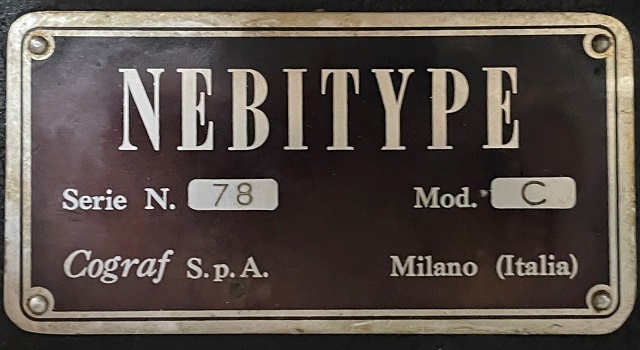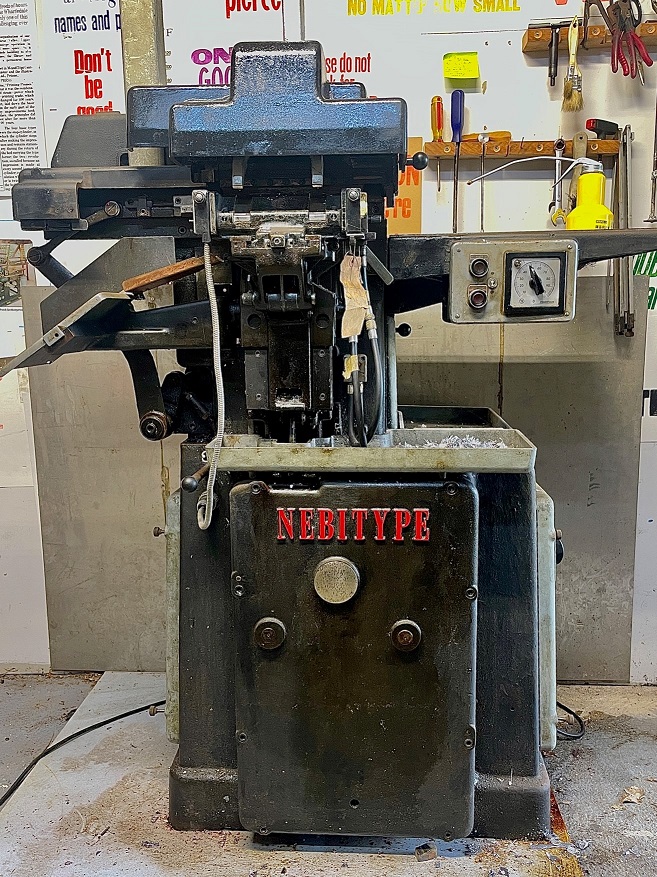Nebitype Model C, Serial #78

History of "NTC #78"
The Nebitype Model C Line Caster #78 came to me via the Pioneer Museum in Taranaki after they 'upgraded' to a Ludlow machine in 2022.
The Nebitype was donated to the Pioneer Museum in 2018 by the NZ Printing Museum in Wellington.
Prior to that it was owned by Alwyn Richardson in Helensville Auckland, who also had a couple of other linecasters originally belonging to the
Auckland Star, so it's reasonable to assume that the Nebitype came from the same place.
The Nebitype linecaster was purchased from Alwyn by the Printing Museum in 1997 for $300 and was relocated from Auckland to Wellington by Bill and Jack Nairn - transported horizontally in the back of a Mitsubishi L300 Star Wagon in driving rain. Madness!
The Nebitype was donated to the Pioneer Museum in Taranaki, NZ and much of the work to restore the Nebitype to operational service was performed there by their dedicated group of volunteers.
No-one really knows for certain exactly when the NTC was manufactured as records of the various Nebitype models and manufacturing dates is pretty scarce.
Based on the manual metal feeder alone, it's possible that this is one of the earliest Nebitypes to still be operating.

Nebitype and Nebiolo
Nebitypes were manufactured by the Nebiolo company in Turin (Torino) Italy, and it was estimated that only around 20 models were imported into
New Zealand, all going to Newspapers. Nebiolo also produced printing presses, paper and handset type.
Nebiolo was fairly late in producing line casters and the market for machines like this was pretty much cornered by Ludlow and its Typograph.
A similar model to mine is in storage at the Powerhouse Museum in Sydney.
Nebitype Models
There were various models of Nebitype manufactured, though it is difficult to catalogue them due to the scarcity of information. NTC #78 is a fairly early version of the Model C as it has a mechanical typemetal feeder, whereas most documentation shows a solenoid-driven electrically operated feeder.
Modifications were made to the machines over the years with some of these modifications being applicable to all models while others were specific to a certain model (or even a certain model after a certain serial number), so some models could be configured with improved features. (I.e. later models could be retrofitted to cast variable length lines, however this was not a standard configuration). Often a modification would have some other prerequisite modifications to ensure the upgrade worked successfully.
The only Nebitype Models that I know about are the Model C, The Ultra and the Ultra-E. (A little more info here.
Nebitype vs Ludlow
The Nebitype is probably most commonly compared to the Ludlow Typograph, which was a far more ubiquitous machine.
One of the Nebitype's claims to fame was that it could cast from 'any' linecaster matrix, including Ludlow and Linotype/Intertype matrices,
as well as the mats produced for the Nebitype by Nebiolo themselves.
The Nebitype matrix catalogue was fairly sparse. Not many typefaces were produced for the machine, most likely because of the availability
of other linecaster mats and probably because of the decline of letterpress. Nebitype faces included: Bodoni, Clarendon & Times Roman amongst
others, as well as some Nebiolo designed fonts like Recta.
Nebitype machines, like Ludlows were often used for titling where the size of the typeface was larger than Linotype and intertype machines were commonly configured to produce, the upper limit for these machines generally being around 24pt. (Larger type could be cast on those linecasters but it required some setup and the Lino/Inter-type machines were very high speed machines for their time and produced the majority of the 'copy' text for newspapers. It's less likely that one of these machines would be permanently set up for titling.)
Another of the Nebitype features was the ability to cast a line 42ems (~178mm) long, which was longer than many other linecasters.
The Nebitype also came with an 84em stick, which was, in essence, two 42em sticks in one.
The downside of this is that the Nebitype (without the variable length slug upgrade) always cast a slug 42ems long, so a composing saw was
required to trim the unneeded body length where short lines are required.
Nebitype slugs resemble Ludlow slugs in being 'T' shaped, with the typeface cast at the top of the T. The body of the slug (the "vertical" part of the T) was either 6 or 12 point in size depending on the size of the typeface being cast and the mould in the machine. The 6pt mould was used for any font with a point size under 12pt while the 12pt mould was used for 12pt and above.
Because of the T shape of the slug, the slugs require underpinning for support under printing pressure. A blanking stick is inserted into the stick holder and the Nebitype run to produce 6 or 12pt blank slugs.
As noted, the mould assembly dictates the body size and length. Nebitype produced two mould sizes, 6pt and 12pt. The mould assembly is water cooled internally to ensure the cast slug is solid before being ejected into the slug tray, a process which relies on the operation of a coolant tank and water pump, built into the body of the machine.
One of the main differences between the Nebitype and the Ludlow machine is that the Nebitype uses a cam-driven elevator to lock the type against the mouthpiece whereas the Ludlow has a manually operated locking lever. Both systems should be able to prevent the occurrence of a 'squirt' so long as the machine is correctly adjusted and sticks and mats are correctly installed.
One thing that the Ludlow has that the Nebitype (particularly old Nebitypes) doesn't is quiet operation. See NTC #73 running in the video below. It'd be nice to say that this is just a noisy machine but the Ultra E at the NZ Printing Museum has a fairly similar operating volume...